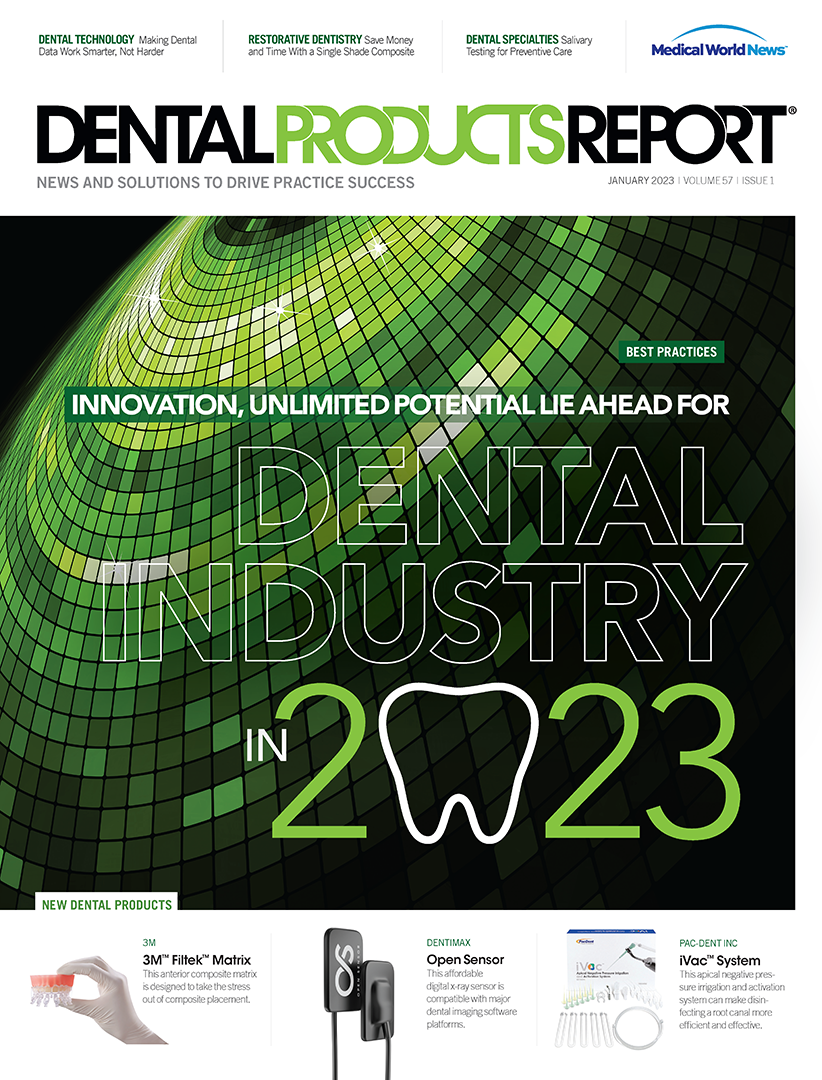Making Dental Data Work Smarter, Not Harder
Digital data are plentiful in the dental practice, so it’s vital to know which are relevant where and how to use them to make the right decisions.
Making Dental Data Work Smarter, Not Harder. Image courtesy of gonin/stock.adobe.com.

What follows is a true story from a time very early in my career and something most of you will have experienced at some point. Dental technology was in its infancy then, and I was in a hotel ballroom in my hometown of Kansas City, Missouri, where a dental supply company was showcasing its cutting-edge equipment.
The intraoral cameras in particular were garnering a great deal of attention; many doctors, including me, were fascinated by the images and expressing their amazement. Then a dentist, perhaps already past the age of retirement, came by, peered at the screen, and wrinkled his nose. “That’s just an excuse to sell people unneeded dentistry!” he said with obvious disdain. The rest of us said nothing. I kept thinking that a punchline would be coming, but then with a “harrumph,” the man turned and walked away. The rest of us stood in awkward silence until one of us said something like, “Well…no sale there!” We chuckled and went back to our conversation about how wonderful it would be to be able to educate patients about their conditions with these cameras.
Later, as I continued to explore technology and all its benefits, I would occasionally hear similar arguments from naysayers. Don’t get me wrong, everyone is entitled to an opinion. I may not agree with it, but they are certainly entitled to it. I think the mistake many naysayers make is in thinking that technology makes decisions. Nothing could be further from the truth.
New technologies allow us to gather more data. A radiograph offers information about interproximal structure and bone height, and we can use that data to inform treatment. How we arrive at a decision is based on the amount of data at our disposal. The more data available, the better our decisions tend to be.
Drowning in Data
We all know I love technology, but I would be the first to admit that we are drowning in an ocean of data. I haven’t seen any numbers on the subject, but I would love to know how much digital data is generated each day at an average practice. Then we could extrapolate how much data is generated in a year. I would bet that most of us would be stunned by the number.
The good thing is that all that data give us decision points about treatment. As I tell patients, the longer they are in my care, the better I become at providing definitive treatment. We all know that some people have rapid breakdown due to decay while others experience extremely slow breakdown under the same circumstances. All deserve tailor-made treatments based on their particular data points.
For example, let’s say an 80-year-old woman presents for recare. She has only 1 buccal pit restoration, which dates back 20 years. She has been a patient for 15 years, never misses an appointment, and her home care is meticulous. This time, there is a slight stick on the distal pit of tooth #30. Should an immediate restoration be recommended? In my opinion, no. But what if an 18-year-old man—who has missed many appointments over the past decade, whose home care is atrocious, and who has multiple 1- and 2-surface restorations—presents with the same problem? Should an immediate restoration be recommended? In my opinion, yes. The situations require different decisions because the relevant data are completely different.
As I said previously, the more data we have, the better we can be at making clinical decisions. But I don’t feel that is the case at present. In addition to accumulating data, we also need to take time into account. No matter how much data you have from an exam done right now, it gives you only a small snapshot of what is going on at this moment.
As most of you have probably read here before, my grandfather was something of a philosopher. One of my favorite sayings of his was, “Experience is what you get 5 seconds after you need it.” I don’t think truer words were ever spoken, and that brings me back to the idea of a data timeline. A timeline gives you information about a patient that is almost like experience. Knowing when to do something is almost as important as knowing how to do it. There is another old expression that I think applies here, “Don’t raise the bridge, lower the river.” So how could we do that?
A Second Opinion
I am confident that 2023 will be heralded as “the year of artificial intelligence in dentistry.” Even as you read this column, the practice where I work is installing Pearl. I took a good look at what was available in the AI space and decided that, with its many clearances from the Food and Drug Administration (FDA), it was the best option available. Pearl’s Second Opinion is the first real-time dental software that is FDA cleared to detect a variety of conditions and pathologies in dental radiographs.
I constantly tell my staff that the hardest thing I do every day is multitask. Ours is a 3-doctor practice with 4 chairs of hygiene running every day. It is sometimes possible to have 1 or 2 patients who need restorative procedures from me and 4 hygiene patients who need me to examine them and make oral health recommendations. Add to this the digital data that we are amassing on each patient, and the task of being in many places at once while incorporating that data into viable treatment plans. It’s a Herculean task. Despite the high expectations our patients have and the immense pressure we put on ourselves, doctors are still human. A doctor running behind on a busy day may miss something on a radiograph. Tired doctors with tired eyes may not be quite as sharp at the end of the day as they were first thing in the morning. Then there are times when we squint at a monitor trying to decide whether we truly see a shadow on an image.
One of the best things about a multidoctor practice is that you can ask a colleague for an opinion. Even better is a having a computer algorithm that analyzes the data. Computers don’t get tired, don’t get eye strain, don’t get distracted. They just analyze data constantly, consistently, and reliably.
Pearl’s Second Opinion looks for several pathologies on radiographs and marks those areas so that you can evaluate them yourself. This brings me back to the intraoral camera I mentioned at the beginning. Only a doctor can make a diagnosis. AI is good at spotting things for you to evaluate or to confirm something you’re not quite sure about. But only when a doctor decides to perform a treatment does the patient receive it.
The other thing about AI is that it provides an unemotional, objective second opinion. It may even suggest that you look at something you might have missed. I’d much rather be told to look at something more closely than to miss it altogether.
Something else I’d like to highlight is the real-time aspect of Second Opinion. When a radiograph appears on a monitor, the software analyzes it and overlays it with markers where it sees potential pathologies. When the doctor walks in for the exam, the images have already been analyzed, marked, and made ready for the doctor to evaluate. With a dual-monitor system, the patient has already seen the images and markings. This is the ultimate in codiagnosis.
Next Generations
Although current AI is nothing short of amazing, time and research are only going to make it better. What really excites me about the future of AI is its potential to generate an even more complete understanding of what we see. I envision a time when we will not only see the data of the patient in the chair, but also know how it relates to that of other patients. Imagine that you take a bitewing and the system tells you something along the lines of “this data has been compared to 813 patients from a similar demographic. In that analysis, the area was found to be carious in 89% of individuals.” Wouldn’t that be amazing? Even if you don’t have the benefit of having treated the patient for several years, you can still use the timeline of other, similar patients to improve your final decisions. In fact, a company called Diagnocat is doing some of that right now.
What I hope we will soon see are highly successful AI companies that can compare what you are seeing in your office against an extensive database of patients from other offices and share statistics in a way that helps everyone’s diagnosis. AI is also making amazing inroads into the digital design of prosthetics that will greatly simplify the in-office milling process.
AI and computer learning have been growing exponentially during the past decade. Many of us are not even aware that a lot of what we do with technology in our personal lives is powered by AI platforms.
Now, at long last, we are seeing breakthroughs in our profession being labeled as AI. When the end of next year comes around, I hope the profession declares 2023 “the year of AI in dentistry.” If that does happen, remember that you heard it here first! See you next month.
